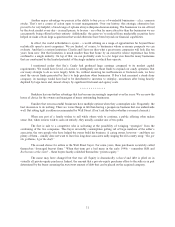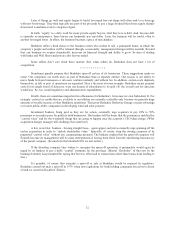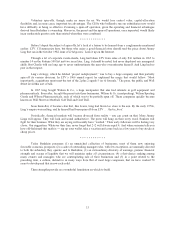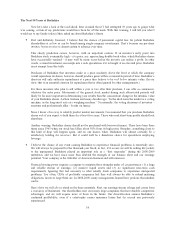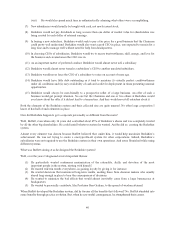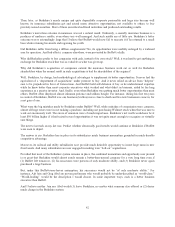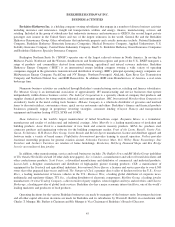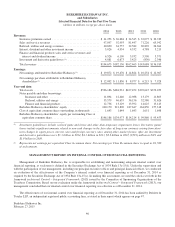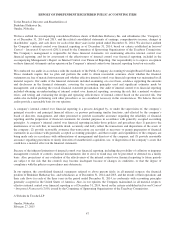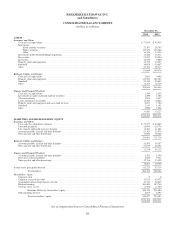Berkshire Hathaway 2014 Annual Report Download - page 43
Download and view the complete annual report
Please find page 43 of the 2014 Berkshire Hathaway annual report below. You can navigate through the pages in the report by either clicking on the pages listed below, or by using the keyword search tool below to find specific information within the annual report.Why did Berkshire under Buffett do so well?
Only four large factors occur to me:
(1) The constructive peculiarities of Buffett,
(2) The constructive peculiarities of the Berkshire system,
(3) Good luck, and
(4) The weirdly intense, contagious devotion of some shareholders and other admirers, including some in the
press.
I believe all four factors were present and helpful. But the heavy freight was carried by the constructive
peculiarities, the weird devotion, and their interactions.
In particular, Buffett’s decision to limit his activities to a few kinds and to maximize his attention to them, and to
keep doing so for 50 years, was a lollapalooza. Buffett succeeded for the same reason Roger Federer became good
at tennis.
Buffett was, in effect, using the winning method of the famous basketball coach, John Wooden, who won most
regularly after he had learned to assign virtually all playing time to his seven best players. That way, opponents
always faced his best players, instead of his second best. And, with the extra playing time, the best players improved
more than was normal.
And Buffett much out-Woodened Wooden, because in his case the exercise of skill was concentrated in one person,
not seven, and his skill improved and improved as he got older and older during 50 years, instead of deteriorating
like the skill of a basketball player does.
Moreover, by concentrating so much power and authority in the often-long-serving CEOs of important subsidiaries,
Buffett was also creating strong Wooden-type effects there. And such effects enhanced the skills of the CEOs and
the achievements of the subsidiaries.
Then, as the Berkshire system bestowed much-desired autonomy on many subsidiaries and their CEOs, and
Berkshire became successful and well known, these outcomes attracted both more and better subsidiaries into
Berkshire, and better CEOs as well.
And the better subsidiaries and CEOs then required less attention from headquarters, creating what is often called a
“virtuous circle.”
How well did it work out for Berkshire to always include casualty insurers as important subsidiaries?
Marvelously well. Berkshire’s ambitions were unreasonably extreme and, even so, it got what it wanted.
Casualty insurers often invest in common stocks with a value amounting roughly to their shareholders’ equity, as
did Berkshire’s insurance subsidiaries. And the S&P 500 Index produced about 10% per annum, pre-tax, during the
last 50 years, creating a significant tailwind.
And, in the early decades of the Buffett era, common stocks within Berkshire’s insurance subsidiaries greatly
outperformed the index, exactly as Buffett expected. And, later, when both the large size of Berkshire’s
stockholdings and income tax considerations caused the index-beating part of returns to fade to insignificance
(perhaps not forever), other and better advantage came. Ajit Jain created out of nothing an immense reinsurance
business that produced both a huge “float” and a large underwriting gain. And all of GEICO came into Berkshire,
followed by a quadrupling of GEICO’s market share. And the rest of Berkshire’s insurance operations hugely
improved, largely by dint of reputational advantage, underwriting discipline, finding and staying within good niches,
and recruiting and holding outstanding people.
41


